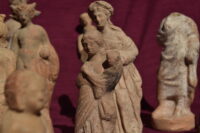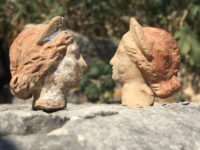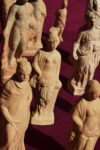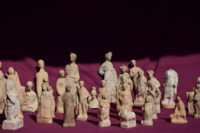 Excavations of the Roman theater in the ancient Hellenistic city of Myra in southwestern Turkey have uncovered a passel of earthenware and terracotta cult figurines. Dozens of figurines were found under a layer silt deposited in the 1st-2nd centuries B.C.
Excavations of the Roman theater in the ancient Hellenistic city of Myra in southwestern Turkey have uncovered a passel of earthenware and terracotta cult figurines. Dozens of figurines were found under a layer silt deposited in the 1st-2nd centuries B.C.
The figurines, that are 2,100 to 2,200 years old included mortal men and women as well as divine figures such as Artemis, Heracles, Aphrodite, Leto and Apollo; they also included figurines depicting a woman and a
child, a boy with a fruit, a horseman and a woman carrying hydria (an ancient Greek water vessel). Because of the “collective coexistence” of the figurines and the fact that the collection included divine figurines, votive plates and incense containers, the researchers think that the figurines may have been brought in from a cult area and thrown here. […]
Some of the statues had partially preserved paint on them. Red, blue and
pink were used “intensely in different shades” in the clothes of the figurines, he said. The inscriptions on the backs of some of the figurines could be the name of a master or workshop. The fact that the team discovered more than 50 terracotta heads that are missing their bodies suggests there are more figurines in the area to be found.
Founded in the 5th century B.C., Myra was one of the largest towns in the 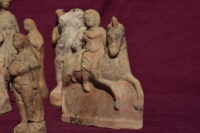 Lycian league (168 B.C. – 43 A.D.) and rose to even higher prominence under Rome. It was the capital of the Roman province of Lycia and its harbor, one of the largest ports on the Mediterranean, was a major center of trade until it silted over in the late 4th century.
Lycian league (168 B.C. – 43 A.D.) and rose to even higher prominence under Rome. It was the capital of the Roman province of Lycia and its harbor, one of the largest ports on the Mediterranean, was a major center of trade until it silted over in the late 4th century.
This past season (June to October 2020) was the 11th consecutive year of excavations at the site. Archaeologists excavated the rooms beneath the Roman theater’s stage, uncovering the ancient orchestra section and remains from a smaller Hellenistic-era theater. The figurines were found scattered among them.
